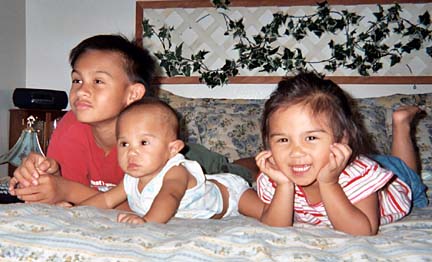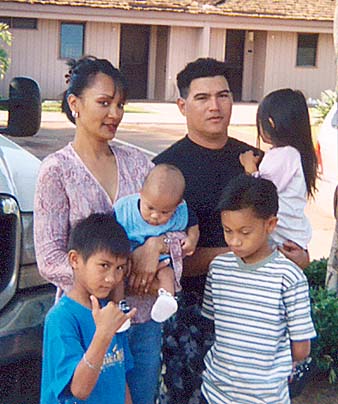
COURTESY OF THE MANABA FAMILY
Akone Manaba, above middle, plays on the bed with his brother, Bronson, and sister Lahilahi.
A very special
first birthdayIt has been a difficult life
for little Akone Manaba,
who will turn 1 on June 19
Jersula Manaba, of Molokai, said she once asked her grandfather, the late Henry Peters Sr., why big parties were held for babies when they turned 1.
Visiting physicians
Two renowned mainland doctors worked with physicians at Kapiolani Medical Center for Women & Children last week on complex heart cases involving infants and adults.
play big part
in 'Heart Week'It was one of five "Heart Weeks" held annually by Kapiolani, with visiting physicians joining in performing heart surgery and interventional procedures, mostly on children.
Dr. John Lamberti, pediatric cardiac surgeon at the Lucille Packard Children's Hospital at Stanford University, has been coming here for years to participate in Heart Week. He works with Dr. Carlos Moreno, director of Kapiolani's Pediatric Cardiac Program, on complicated cases.
With development of minimally invasive interventional techniques, Kapiolani selected Dr. John Moore last year to come here during Heart Week and head a new interventional service. He is an interventional cardiologist and Cardiac Catheterization Laboratory director at Mattel Children's Hospital at UCLA.
Doctors Venu Reddy and James Sim, Kapiolani pediatric cardiologists, worked with Moore last week in the catheterization lab at Straub Clinic & Hospital, Kapiolani's sister facility.
They use nonsurgical procedures, such as cardiac catheterizations, angioplasties and stent placements, to treat congenital heart disorders.
"He said in the old days, if they survived the first year, it was very significant. They didn't have medical care like now."
When 600 family members and friends celebrate Akone Manaba's first birthday with a luau June 20 on Molokai, it will be a tribute to modern medical care.
Akone has been hospitalized four times since he was born two months early on June 19.
He is the fourth child of Jersula and Dedric Manaba, a self-employed heavy equipment operator on Molokai.
"He is a very happy baby," his mother said. "He has a jolly laugh. He laughs from the na'au (the gut), as Hawaiians say. ... He has no idea what he's been through."
More than 30 doctors have attended Akone in his first months of life, and he sees seven regularly in Honolulu, she said.
"He is a tough little kid," said pediatric cardiologist James Sim, among those who have worked on correcting Akone's medical problems.
Manaba said she told Dr. Donn Tokairin, her obstetrician-gynecologist, in a monthly checkup last June at his Kuakini Hospital office that she felt funny and thought something was wrong. He sent her to Kapiolani Medical Center for Women & Children for tests, which showed she did not have enough water to hold the baby, she said. He was born by emergency Caesarian section. He weighed 4 pounds 9 ounces and was 14.5 inches long.
Manaba said she was not aware until the next day that he had to be resuscitated.
"I had only three seconds to see him before they rolled him away."
A heart murmur was detected in the baby a week later, she said.
Dr. Kenneth Ash, neonatal specialist, explained to the parents that the baby's largest artery, the aorta, was constricted.
The Manabas decided surgery was necessary after meeting Sim and Venu Reddy, Kapiolani pediatric cardiologists.
"We thought as the baby grows, it (the aorta) would get more narrow, and he may not be able to pump out enough blood and oxygen," Jersula said.
On July 21, Dr. Carlos Moreno, head of Kapiolani's Pediatric Cardiac Surgery Program, performed surgery to open the artery.
Manaba said her husband and children; his parents, Joseph and Dodie Manaba, of Molokai; and her father, Roger Montero, of Honolulu, originally from Molokai; and aunt, Stephany Peters, of Honolulu, were all present for the stressful event.
Their entire community on Molokai also was pulling for their son, she said. "He was on a few prayer teams for all different religions."
Akone recovered so well that he was released directly from intensive care July 28, she said.
"They said he just needs mom and dad's loving care now."
After a week in Honolulu to follow up on appointments, mother and son returned home to a big welcome at the airport.
COURTESY OF THE MANABA FAMILY
The Manaba ohana: Hunter (making shaka), Bronson, Jersula (holding Akone) and Dedric (holding Lahilahi).
"There are lots of caring people wanting to know how the baby is doing, keeping us strong," she said.
Another setback occurred the next week when Manaba noticed the baby "seemed to be going unconscious" when she was feeding him.
He had been fed with a tube in the hospital and did not know how to suck, swallow and breathe when she gave him a bottle, she said.
"It was going down the wrong pipe into his lungs."
She said she had learned cardiopulmonary resuscitation because of her job at Hale Mahaolu, a housing facility for seniors.
"I didn't have to do it, but there were close calls when he turned nearly purple. I was blowing in his face, trying not to panic, and the children were crying, 'Mom, he's blue.'"
He was taken by medical helicopter to Honolulu on Aug. 28 and admitted to Kapiolani again for 10 days. Manaba learned how to use a thickening gel and a certain type of nipple to help the baby swallow her expressed breast milk.
On Nov. 13, Akone was back in Honolulu at Straub Clinic & Hospital for an angioplasty because scar tissue at the surgical site had narrowed the aorta again.
Dr. John Moore, interventional cardiologist and Cardiac Catheterization Laboratory director at Mattel Children's Hospital at UCLA, was here for Kapiolani's "Heart Week." He and Sim opened Akone's artery with a tiny balloon-tipped catheter inserted through a small puncture in the groin.
After the 45-minute procedure, Manaba and Akone went by ambulance to Kapiolani where the baby was observed for a day.
"When we saw him the last time in the hospital, his artery was wide open," Sim said. "I think we fixed the problem."
But he must be followed because the artery could narrow again, he said.
Last month, Akone was back in Kapiolani's familiar emergency room with a chest cold and wheezing. He was on oxygen for three days, his mother said.
The baby has been battling still other problems. He has had frequent ear infections, and his right nasal airway was too small. Dr. Lenhahn Tran, Kapiolani ear, nose, throat doctor, has been seeing him every month since August, Manaba said. Both nasal airways are the same now, she said.
Two more surgical procedures are scheduled in July and December to lengthen his urethra, the tube leading from the bladder that discharges urine outside the body.
Although Akone must be watched closely, Manaba said, "We've been hitting milestone after milestone." He is eating baby food, speed-crawling around the house, and his language is at a normal range. He is up to 15 pounds, 2 ounces and is 26 inches long, she said.
"If you don't know his past, you think he's normal. Except for the scar from major heart surgery, you can't tell he's been through something."
— ADVERTISEMENTS —
— ADVERTISEMENTS —

